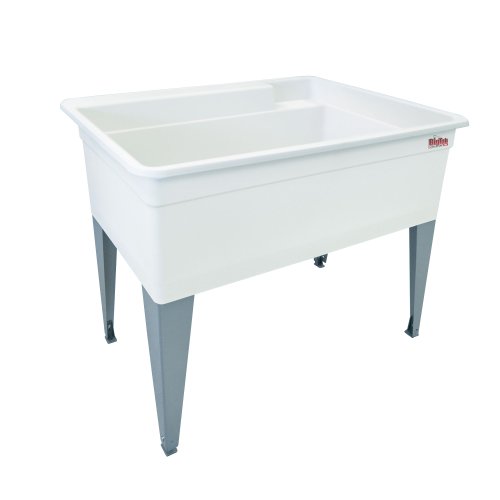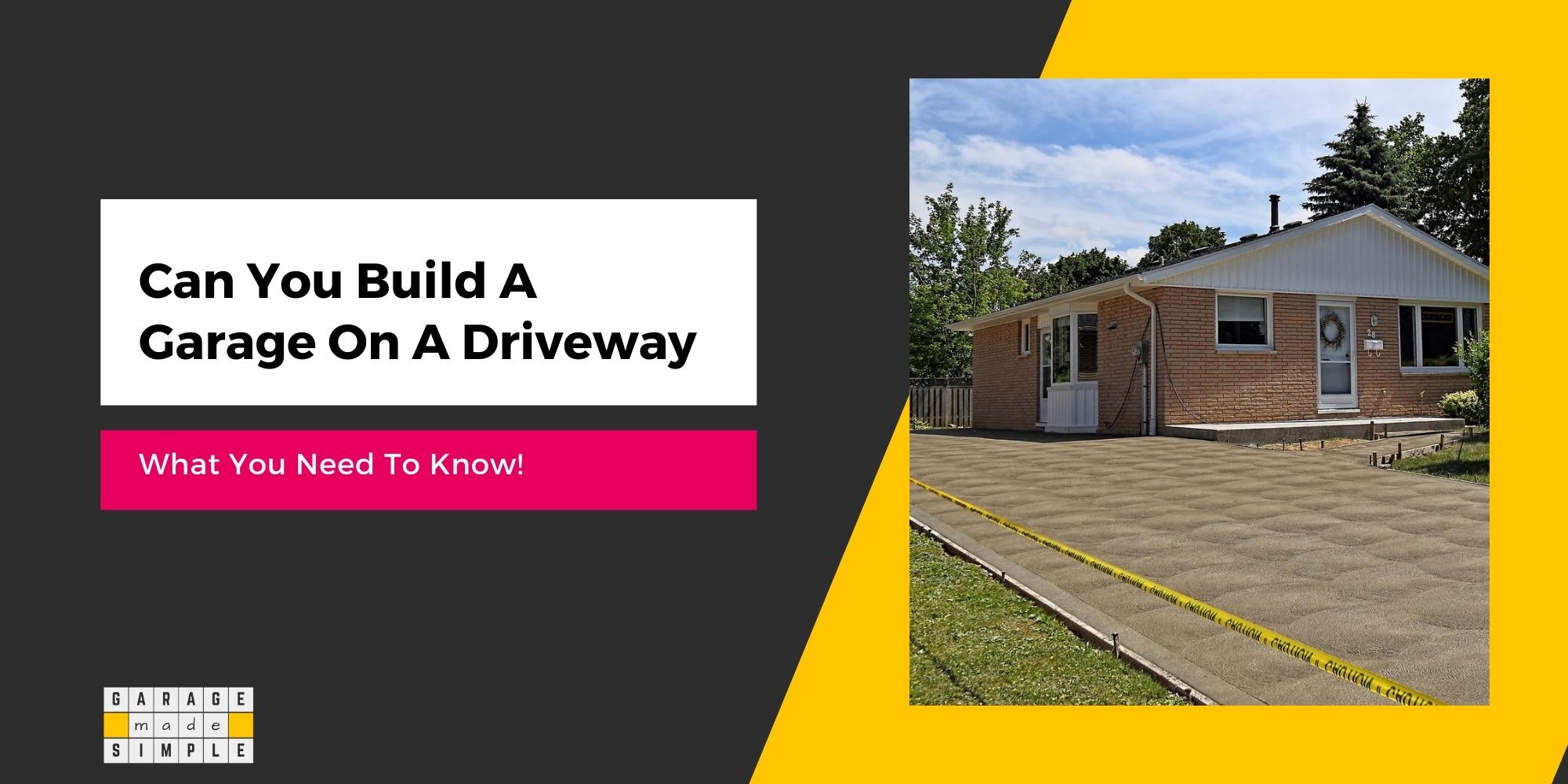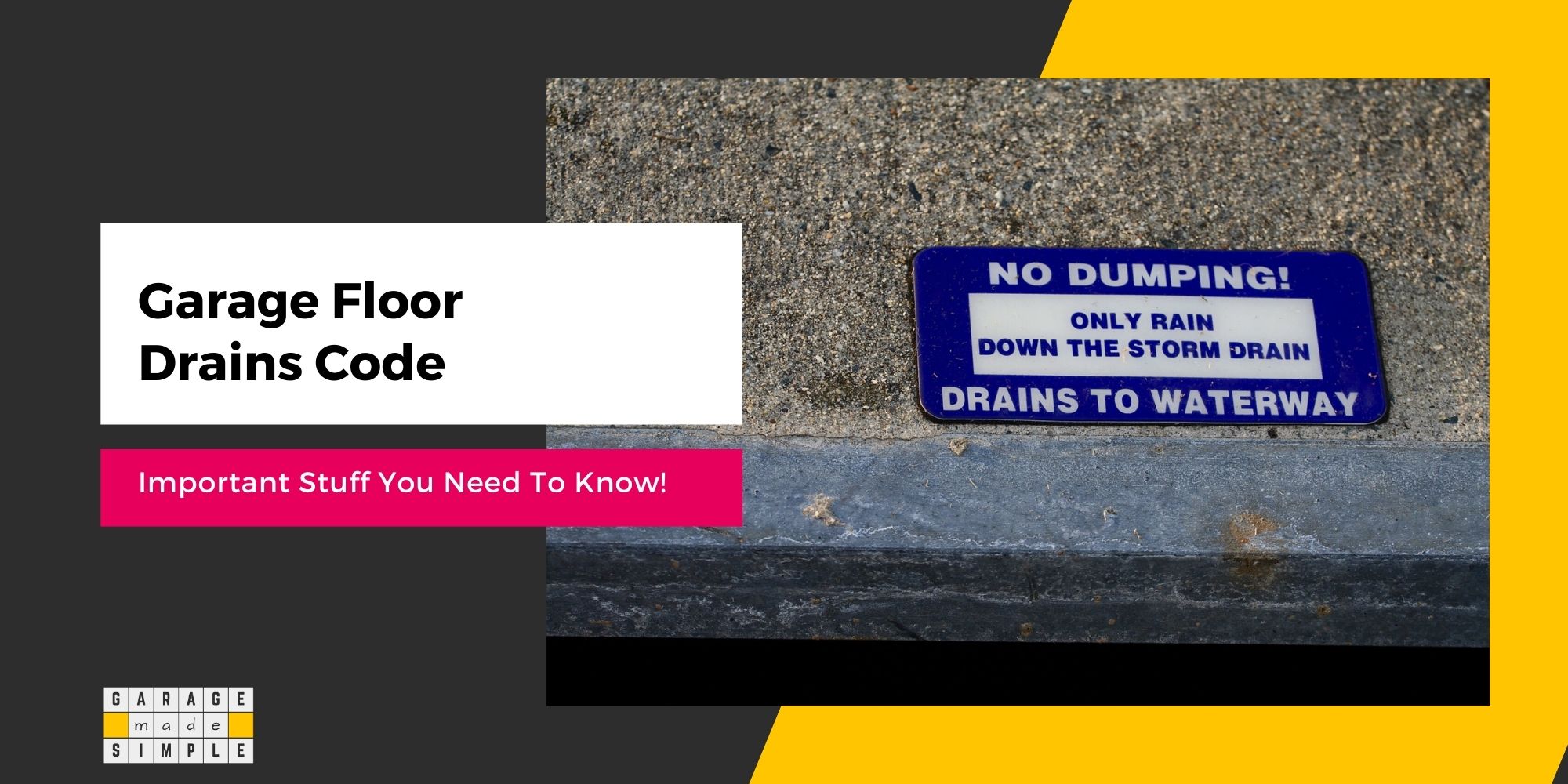Garage Utility Sink Installation: Practical Tips & Tricks!
garagemadesimple.com is a participant in the Amazon Services LLC Associates Program, an affiliate advertising program designed to provide a means for sites to earn advertising fees by advertising and linking to Amazon.com . The website is also an affiliate of a few other brands.
Can You put a Utility Sink in the Garage?
Whenever you work on anything in the garage, you are sure to get your hands dirty. It could be a paint job or just changing the tires. So how do you clean up without having to walk back into the house to your kitchen sink? Don’t you wish you could have a garage utility sink?
Garage utility sink installation is a relatively simple DIY project, if you have some experience in plumbing. You also have the option of using a portable sink that does not require any plumbing.
Installation of a garage utility sink will simply change your life. You will be amazed at the number of ways you are able to use it.
Why Do You Need a Garage Utility Sink?
The garage utility sink will let you clean up before entering the house. The obvious benefit is your house remains clean.
Here is a list of a few occasions when you will find the garage utility sink really handy.
- Fixing a few things on your car? Get your hands all clean before entering the house.
- Mopping your garage floor to make it look clean & new? Clean the mop in the garage utility sink after you are done.
- Been doing some outdoor gardening or like to grow vegetables in the garage? Clean up the rakes and the shovels in the garage utility sink before storing them.
- Took the dogs out for a walk? Give them a shower in the garage utility sink so they don’t muck up the house.
- Had a little party in the garage? Clean up the dishes in the garage utility sink.
- Your kids have been doing their arts project in the garage? Even the utility mats can get messy. Clean up all the mess in the garage utility sink.
Honestly, once you have a garage utility sink, you will wonder how you managed without one all this time.
What Type of Garage Utility Sink Do You Need?
Yes, that is the first and possibly the most important question that you need to ask. Obviously the type you need depends on what you are going to use it for, most of the time.
What Sizes Do Garage Utility Sinks Come In?
You do not need a large garage utility sink if the purpose is just to get your hands clean before you enter the house. A small hand washing sink will serve your needs pretty well. The sink dimensions in this case could be as small as 12″(L) X 12″(W) X 6″(D).
Stainless Steel Hand Sink with Side Splash – NSF – Commercial Equipment 12″ X 12″ from Amazon is an excellent example of a compact hand wash sink suitable for garage use.
On the other hand if you are going to be using your garage utility sink for giving your dogs a wash or for cleaning the garden rake, then you need something considerably bigger. Go as big as 40″(L) X 24″(W) X 14″(D).
Mustee 28F Bigtub Utilatub Laundry Tub Floor Mount, 24-Inch x 40-Inch, White from Amazon is large enough to meet your requirement of a big garage utility sink. You will find many uses for it.
Is Stainless Steel Good for a Garage Utility Sink?
When choosing the material of the garage utility sink, keep in mind that you want something that is
- Rust Proof
- Corrosion Resistant
- Stain & Scratch Resistant
- Unbreakable
- Lightweight
Impact Resistant Polypropylene will tick all the boxes and yet be easy on the pocket. Stainless Steel is a great option, but a lot pricier.
Porcelain used to be popular (and still is when it comes to bathroom fixtures), but quite unnecessary in the garage, in my opinion.
Can You Put Any Faucet on a Utility Sink?
The plumbing requirements for a laundry sink faucet and a utility sink is the same. However, the two types of faucets come in different designs to suit the requirement.
Quite often the utility sink does not come with the faucet, which is a good thing. When it comes to faucets, everyone has their own special needs and preferences. So it is best to buy it separately and install it
Some options that you can look at are:
- Standard Two Handle (Hot & Cold Water) Faucet. Ensure that the spout is threaded so that you can use different attachments, such as a sprayer. Click Link to view Moen 8277 Commercial M-DURA 4-Inch Centerset Utility Faucet, Chrome from Amazon.
- Two Handle (Hot & Cold Water) Faucet with Pull Out Sprayer Spout. Click Link to view Glacier Bay Pull-Out Laundry Faucet from Amazon.
- Single Handle Lever Type Faucet. More convenient as you can control both the flow volume and the temperature of the water with just one hand. It may come with or without a Pull Out Sprayer Spout. Click Link to view this top of the line HUIJK Single-Handle Pull-Out Laundry Utility Faucet in Vibrant Stainless from Amazon.
If you are using the utility sink in the garage for more than just washing your hands, then you need to give special attention to the Spout and the Sprayer.
Spouts can swivel and Sprayers can have a longer hose length. You also want more than one option on the spray type and the spray pressure.
That way you have more flexibility. You could easily switch from a hard spray to remove dried out mud from shoes to a gentle rinsing off of soap from your pet pooch.
How do You Install the Water Pipes to the Sink?
Not all garages are the same. I am sure your garage is a bit unique in its own way.
Laundry Room in Garage
Some homeowners have chosen to have their laundry room either in the garage or adjoining the garage. This idea is not without its merits.
Should you be considering this thought then check out my blog post How to Make an Enclosed Laundry Room in a Garage for some ideas. You may then add the utility sink in the laundry room in the garage, alongside the washer. This would be killing two birds with one stone.
Mudroom in Garage
Other homeowners, almost always, use the garage entry door to the house rather than the front door. So much so that they have set up a mudroom right there in their garage.
What do you think? Were you to do this, you would have no need for a separate garage utility sink. Just incorporate it in the mudroom in the garage. Not convinced? Why not check out my post Why Add Mudroom Entry From The Garage? 7 Really Great Reasons.
Bathroom in Garage
Should you decide to put a bathroom in your garage, you could put the utility sink within the bathroom. The idea of a bathroom is a pretty good one, especially for a detached garage with a workshop, gym or yoga space. It is so much more convenient to take a shower, after a workout, without having to go all the way to the house.
Where Should You Put the Utility Sink?
Having a laundry room, mudroom or bathroom in the garage is helpful as the plumbing and space are already there. But they are not a prerecquisite.
Do not have existing plumbing to or drainage out of the garage? No worries! You can install water lines to the sink. In that case, it would be helpful, if the location of the sink is such that it is near:
- The wall adjoining the house
- The garage entry door to the house
- A kitchen, laundry room, mudroom or bathroom that has water supply
- A drain
How Do You Plumb a Sink into a Garage?
If you are not too sure of your DIY skills in the plumbing area, then get a good plumber to do it for you. It will cost some, but, trust me, the results will be worth it!
But if you want to do it yourself, that’s great too. It’s not too difficult when you have some skills, the right tools and the required supplies.
Running a water line from your home to an attached garage or a carport attached to the garage is a bit easier as you just need to drill a hole through the adjoining wall and run the pipe line through it. The work is a bit more tedious if you are running a water line to a detached garage.
Most houses will have a water outlet outside the house for the garden hose. Use that if possible. Cut into the pipe line and install a Tee. You will need to bury the pipe going to the garage. So that’s the extra bit of work & cost.
TIP: Use PEX pipes. They expand and are unlikely to burst even if they freeze.
The Process
Start off by making sure that the main water line is shut off before you start any plumbing work. Also open all the taps so that all remaining water in the house pipes is drained. You do not want your house flooded.
You need to tap into the existing cold and hot water lines in the house by installing a Tee. Here it is important to install a ball valve on the section leading out to the garage.
This way you can shut off the water supply to the utility sink in the garage from within the house.
Run the PEX water pipes from within the house to the garage through a hole in the drywall. The pipes should be run to a point close to where you intend to locate the sink.
At this point the PEX pipe should be joined with copper tubing which then connects to the sink faucet. The hot water and cold water tubes should have control valves to control the water flow.
As a safety measure, fit check valves at the joints. The check valves are one-way valves. Water will always flow from the house to the sink and never the other way around.
It is also a good idea to screw on large, clear or white plastic sheets on the garage wall behind the utility sink. That way your drywall will never get wet from water splashes from the utility sink.
Will the Water Lines of the Garage Utility Sink Freeze in Winter?
Yes they will if your garage is not climate controlled and the garage temperature drops to below freezing.
You really have 3 options:
- Climate Control your Garage. I know you are not going to spend a ton of money just to protect the plumbing of the garage sink. But a climate controlled garage has a host of benefits. Free flowing water in the garage utility sink just happens to be another one of them. Get full details by reading my post How To Make Sure Of Best Climate Control For Your Garage.
- Insulating the cold water pipeline.
- Switching off the water supply when the outside temperature dips below freezing.
How to Set up the Drain for the Garage Utility Sink?
This is a rather simple job as you can get all the supplies from Home Depot or any other hardware store.
You need a Tailpiece that attaches to the utility sink drain hole. Most importantly you need a P-Trap. This comes as a Kit. The function of the P-Trap is to ensure that smelly sewer gasses do not waft into your garage.
In a way it’s like a one-way valve. Drain water can go to the sewer but sewer gasses can’t come back in.
All you need to do is connect the Tailpiece to the P-Trap using a Tailpiece Extension and connect the end of the P-Trap to the pipe leading to the drain.
All plumbing is PVC so if any cutting is required that is quite easy. Be sure to use PVC Cement and Teflon Tape on the threads to ensure all joints are sealed and there won’t be any leakage or dripping.
Can You Install a Garage Utility Sink Without Plumbing?
What if you do not want to go through all this trouble, but you still want a garage utility sink? At least to wash your grimy hands after being on the workshop bench for a while.
In that case you can buy one of the portable sinks from Amazon.
- No water installation or drain hose required. Only plug into a 110v outlet and fill the fresh water tank.
- Stainless steel NSF approved sink, high quality and durable. Cabinet is made out of injection molded polypropylene that is: Germ-resistant, Maintenance free, Will not warp, Will not rust and Will not dent
- The sink is equipped with a quality water pump, a FLOJET BW5000 Bottled Water System. The water heater is an EEMAX Mini Tank Electric Water Heater with a thermostat to adjust the temperature range (50°F to 140°F).
FAQ
What Is the Difference Between a Laundry Sink and a Utility Sink?
The main difference between an utility sink and other types of sinks such as laundry sink, kitchen sink and bathroom sink is its size, functionality and durability. While utility sinks can come in a range of sizes, they tend to have more width & depth than a laundry sink.
The utility sink, as the name suggests, can be used for multiple types of washing & cleaning operations. While you would use the laundry sink to just pre-wash dirty clothes, you can use a utility sink to wash almost anything that is messy & grimy.
Utility sinks are often used to clean or wash grimy hands, muddy shoes, garden equipment, garage tools, etc. You can even give your pets a bath in a utility sink.
How Tall Should a Utility Sink Be?
The depth of a utility sink can range from 8 inches to 24 inches. The size that you select will depend on the space available in your garage and the planned use.
For example, if you have mid size dogs and you plan to give them a bath in the utility sink, then you should be picking a utility sink that is 24 inches deep
When installing the utility sink in your garage make sure that the top of the sink is chest high. For a deep utility sink, try and keep the bottom of the sink waist high.
Can You Drain a Sink into the Ground?
You cannot drain a sink into the ground. This will certainly be against the local regulations.
The general rule for drainage is that rainwater can be and should be drained to the storm water drainage system of the city or municipality. All other waste, including those from utility sinks, should be drained only to the sewage water drainage system.
You can drain rainwater to daylight. However, the output of a utility sink is certainly not clean and cannot be considered the equivalent of rainwater.
How Much Does It Cost to Install a Utility Sink in a Garage?
The cost to install a utility sink in your garage will have 3 components:
Utility Sink Cost: The cost can range from $100-$700 depending on the size and the material of the utility sink.
Plumbing Material Cost: This will depend on the length of the water pipe, from your home to the garage and the distance from the utility sink to the sewage drain. PEX water pipes cost between $0.50-$2.00 per foot. PP drains cost between $1-$10 per foot.
Labor Cost: An experienced plumber would charge you $200-$500 to install the utility sink in the garage. This does not include putting in the additional water pipe and drains.
The costs are indicative only and can vary depending on your location and specific needs.
Thank you very much for reading the post. I do hope you found it informative and useful.








